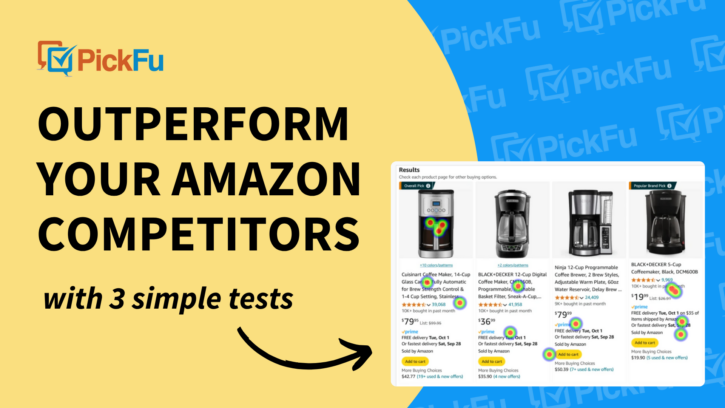Are rival products outselling you even though yours is just as good – or better?
Seeing their listings climb the rankings while your sales stall can be maddening. Success on Amazon isn’t only about price or product specs; it’s about knowing exactly what convinces shoppers to click Add to Cart.
The fastest way to find out? Ask shoppers directly. In this guide, you’ll learn a three‑step, consumer‑powered process to uncover why customers choose competitors, where your listing falls short, and how to fix it – fast.
Why consumer research should be a key piece of your competitor analysis
Most Amazon competitor analyses rely on surface‑level data: keyword overlap, sales estimates, or price trackers. Useful, but they don’t reveal the “why” behind shopper behavior.
That’s where PickFu comes in. Our platform lets you poll real Amazon buyers who match your target audience. Within minutes, you’ll learn:
- Which images, titles, or price points grab attention
- What features or benefits shoppers actually care about
- Where competitors leave gaps that you can fill
Because the insights come straight from potential customers – no assumptions, no guesswork – you can make confident changes before risking conversions.
3 quick tests to reverse-engineer competitor listings
To show the process, we’ll use an LED face mask as an example. Swap in your own product, follow the same steps, and watch your metrics move.
1. SERP Click Test: who wins the first click – and why?
Goal: Understand what’s driving clicks to your competitor listings from the Amazon Search Results Page (SERP). Find areas to optimize your main image, title, or price.
Shoppers can’t buy what they don’t click. Start by running a SERP Click Test. Upload a screenshot of the Amazon SERP showing a handful of competing search‑result thumbnails (including yours) and ask your target audience which they’d be most likely to click on first.
Here’s our Amazon SERP Click Test using the LED face mask example.
What we learned:
- Our mask (the second option) earned just 2 clicks; a rival with a vibrant RGB glow image earned 7.
- Respondents cited the competitor’s lower price and cleaner background as tie‑breakers.
Action items:
- Lower or bundle pricing to stay competitive.
- Shoot a hero image that highlights the mask’s multi‑color glow.
👉 Grab the ready‑made Amazon SERP test template to launch in under a minute.
2. Head‑to‑Head comparison test: which listing closes the sale?
Goal: Uncover opportunities to optimize your product detail page and fix any weak points by comparing side-by-side with a top competitor.
Next, discover what happens after shoppers click. In a Head‑to‑Head test, respondents compare your full product page with a top competitor’s and vote for the one they’d buy. Here’s our example.
Findings:
- Our product won, but barely – nearly 50% preferred the competitor.
- Many never realized our mask offered multiple LED colors – the gallery and bullet points buried that detail.
- Shoppers praised the competitor’s lifestyle photos that showed each color in use.
Fixes:
- Re‑order bullets to spotlight adjustable color modes.
- Add lifestyle images that show the real glow effect for every setting.
- Rewrite bullets in a benefit‑first style (e.g., “Blue light calms acne‑prone skin” instead of “Blue LED wavelength 415 nm”).
PS – you can learn more in our complete guide to Amazon A/B testing.
3. Open-Ended competitor weakness poll: exploit the gaps
Goal: Get in-depth qualitative feedback about your competitor’s listing, understand what your audience likes and dislikes about it, and find gaps that you can fill.
Finally, flip the lens. Run an Open‑Ended Poll like this one asking, “What information is missing from this listing?” on your highest‑ranking competitor.
Shopper complaints:
- No details on light‑intensity settings
- Vague durability claims – how long do the LEDs last?
- Unclear if the mask suits sensitive skin or rosacea
- Sparse battery‑life info and no charging photos
Opportunity:
Answer these questions in your own listing: include LED lifespan (e.g., 50,000 hours), intensity chart, dermatologist quotes, and a battery‑life icon.
From insight to action: your 5‑point roadmap
- Prioritize the thumbnail. It controls up to 90 % of click‑through rate.
- Lead with benefits. Start bullets with outcomes (“Glowing skin in 10 minutes”) then add specs.
- Show proof. Use real‑life images and short GIFs (in A+ Content) to demonstrate color modes or usage.
- Answer objections. If shoppers worry about comfort or battery life, tackle those in the first two images and bullets.
- Retest quarterly. Competitors evolve; keep an eye on new entrants and adjust.
Need extra inspo? Check out this video on 5 key PickFu tests that top Amazon brands run.
Save time and outsell the competition
Traditional A/B tests can take weeks and risk revenue. With PickFu, the LED mask polls returned 50 responses in under 17 minutes. That speed turns insights into sales far faster than your rivals can react.
Ready to try it? Create a free PickFu account and run your first competitor analysis today!
FAQs
1. What is competitor analysis on Amazon?
An Amazon competitor analysis is the process of comparing your listing to high‑ranking rivals to uncover gaps in images, pricing, keywords, and benefits so you can improve conversion.
2. How often should I run competitor tests?
Test quarterly or whenever a new challenger gains significant share – fresh data keeps you ahead.
3. Which PickFu poll should I start with?
Begin with a SERP Click Test to diagnose click‑through issues, then run a Head‑to‑Head test for conversion insights. Open-Ended polls can give you deeper qualitative insights about gaps and opportunities.
4. Do I need my listing to be live to test?
No. You can upload mockups or staging URLs and gather feedback before launching changes.
5. How many respondents do I need?
For directional insight, 50 respondents is a solid baseline. Larger audiences give more statistical confidence.



